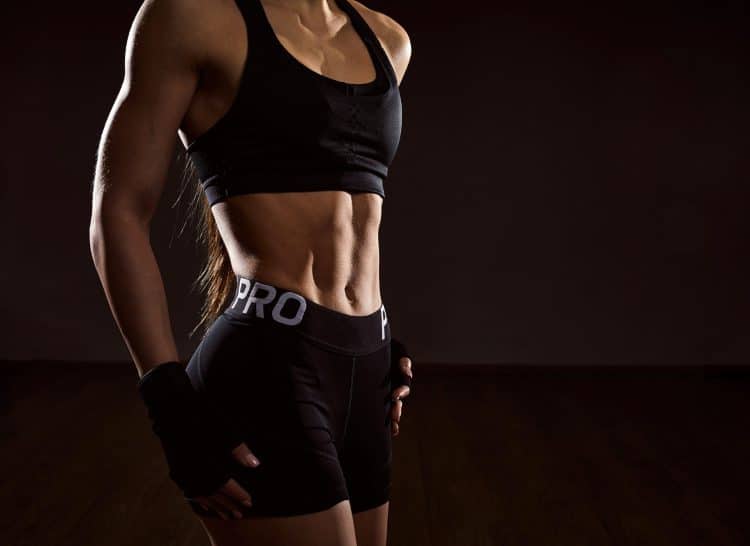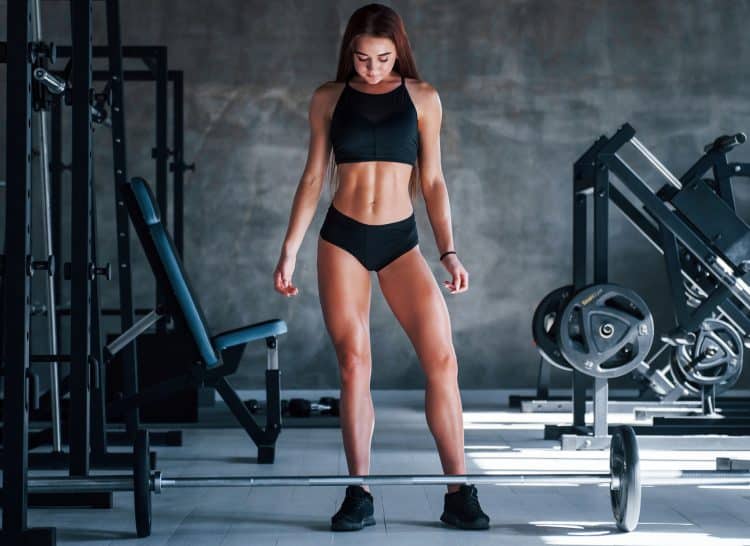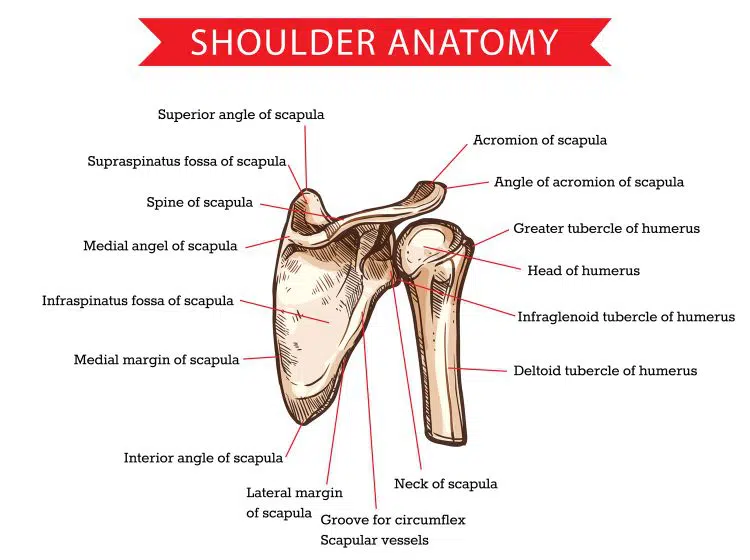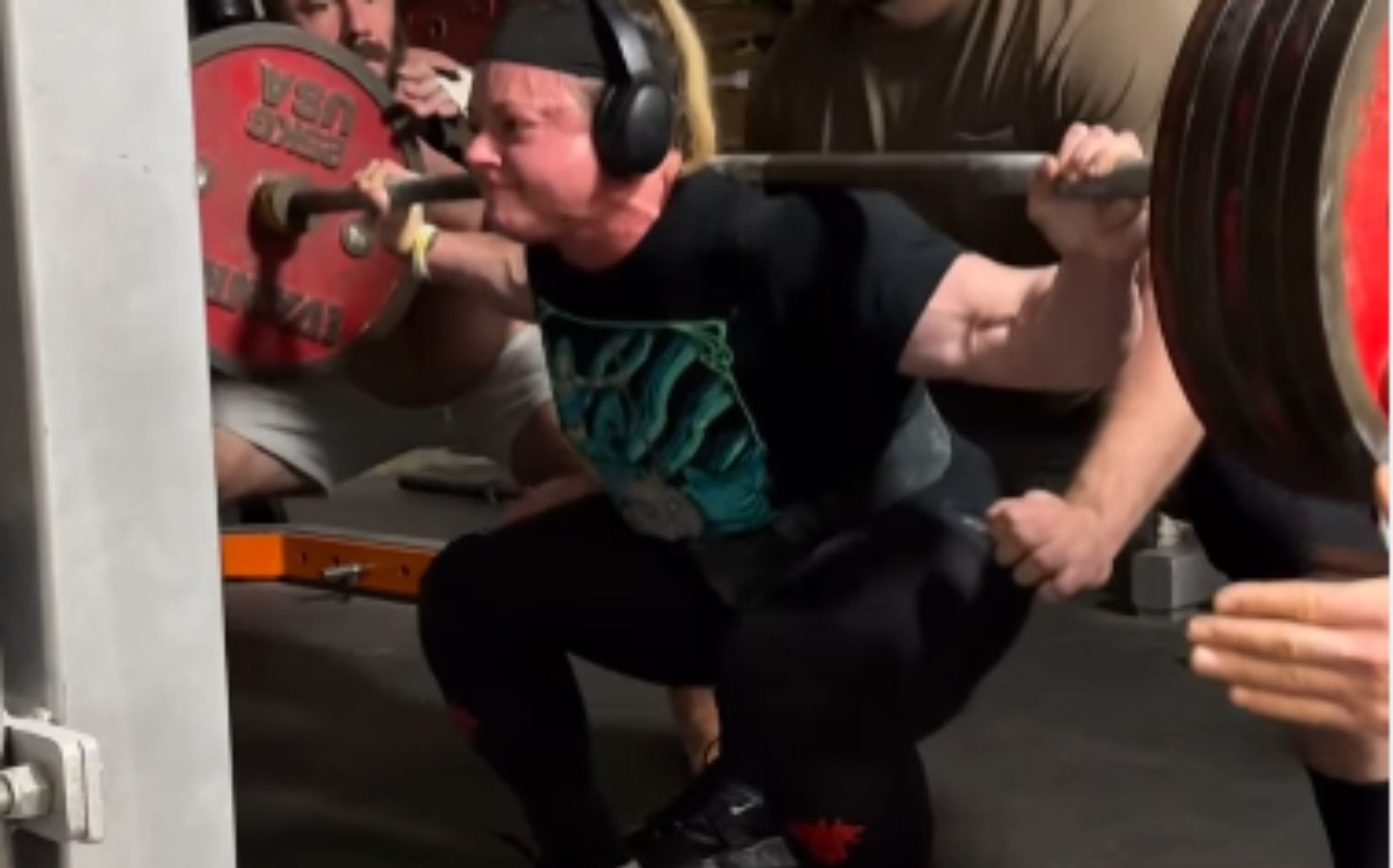Hop onto Instagram, and you’ll see a (not so) disturbing trend. Female fitness influencers post lower-body workouts, promote booty-building eBooks, and sell butt-lifting jeggings. This leads to most women crowding the hip thrust and glute kickback machines in gyms.
Ladies usually avoid upper body exercises because of an undying myth stating that lifting weights can make you burly and manly. However, they have found a clever way around this myth. Girls don’t mind gaining muscle mass on the lower body, but big arms, back, and shoulders are a big no-no.
Training your glutes three to four times a week will help you build a rounder and bigger butt, but overlooking your upper body can create muscle imbalances. If you want an hourglass physique, you must work on your upper body just as hard as your lower half. You need a solid back and round and capped shoulders for a perfect X-frame. Tiny shoulders, a non-existent back, and a big bottom will make you look like a tennis racket. We don’t know about you, but we’ve never heard of anyone wanting a tennis racket figure.
This article covers the upper body anatomy, the benefits of training the upper body for women, the best exercises, and two balanced workout programs for overall development. There is a lot to cover. So, sit tight.
Benefits of Training Upper Body For Women
Below are the benefits of performing upper body workouts for women:
Level Up Your Fitness: Join our 💪 strong community in Fitness Volt Newsletter. Get daily inspiration, expert-backed workouts, nutrition tips, the latest in strength sports, and the support you need to reach your goals. Subscribe for free!
Toned Muscles
Let’s address the elephant in the room. Most women stay away from upper body workouts for fear of looking manly. However, women don’t produce enough testosterone to build the same muscle mass as their male counterparts.
Testosterone is the male sex hormone and anabolic steroid in males. It is vital for developing male reproductive tissues such as the testes and prostate. Testosterone also promotes secondary sexual characteristics such as increased muscle and bone mass and body hair growth.
Contrary to popular opinion, lifting weights can help women tone their bodies, resulting in a sculpted figure.
Promotes Symmetry
Weight training promotes bone modeling, which involves changing the shape and size of bones by adapting to load. It reduces the risk of fractures and getting osteoporosis. [1]
Going cold turkey on your upper body workouts can cause muscular and strength imbalances. Furthermore, training your upper half can improve balance and coordination, reducing the risk of falls and related injuries in older age.
Longevity
Overlooking training your upper body can result in instability, which increases your risk of injury, even while hitting your lower body.
Incorporating upper body exercises in your workouts can improve your ligament, tendon, and cartilage health. Additionally, upper body exercises strengthen connective tissue in your elbows, shoulders, neck, spine, wrists, and hands.
Upper body exercises can improve mobility and flexibility, reduce the risk of chronic diseases, and boost bone density. [2]
Better Posture
Folks that spend most of their days hunched over their phones or computers are prone to developing rounded shoulders. Adding upper body exercises to your training regimen can help fix your bad posture.
Upper body exercise can strengthen your upper back, chest, and shoulders and improve mobility, reducing the risk of related pain and injuries.
Better Strength
You are as strong as your weakest link. Getting stronger requires you to follow a balanced training regimen. Incorporating upper body exercises can improve your overall functionality. It will make you perform better in your lower body workouts and daily functioning.
Increased Metabolism
Upper body workouts help build new muscle tissue, which requires more calories to sustain itself than fat tissue, meaning your body burns more calories at rest to maintain the new muscle mass.
High-intensity upper-body workouts will also elevate your heart rate, resulting in higher calorie burning during the workout. Upper body exercises can also enhance hormonal balance and reduce fat mass, leading to a higher metabolic rate.
Confidence Boost
Gaining strength and muscle mass and losing excess body fat on the upper body can be empowering. Sculpted arms, shoulders, and back will make you feel like Wonder Woman.
Furthermore, setting new PRs in the gym will help you experience a sense of accomplishment and pride and reduce your stress levels and anxiety. [3]
Upper Body Anatomy
You must focus on the following muscle groups in your upper body workouts:
Chest
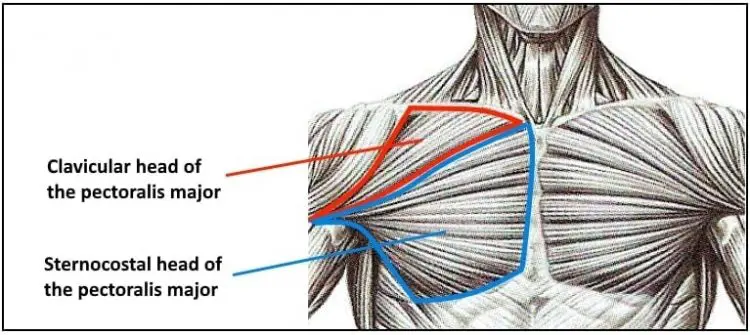
These are the two main muscles in the chest:
Pectoralis major
It is a large, fan-shaped muscle in the upper chest beneath your breasts. The pectoralis major has two heads; you must perform different exercises to train each head optimally. The flat bench press and dips train the sternocostal head, whereas the incline bench press and Guillotine press can stimulate the clavicular head better.
Pectoralis minor
It is a thin, triangular muscle located beneath the pectoralis major. The pectoralis minor is mainly responsible for stabilizing the scapula and helping raise your arms overhead. Chest dips are one of the best exercises for this small muscle group.
Back
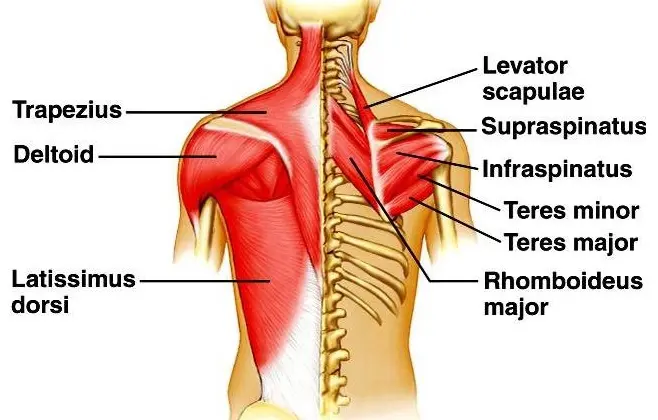
There are two types of muscles in your back — intrinsic and extrinsic. Extrinsic muscles are located in your upper back and connect your arms to your spine. These include:
Trapezius
It is a triangular muscle beginning at your skull base, which extends to the middle of the back and shoulders. Traps help move and stabilize the shoulder blades and neck. Including trapezius exercises in upper body workouts can improve posture, strength, and muscle mass. Shrugs and upright rows are the most popular trapezius muscle exercises.
Latissimus dorsi
The lats are the largest muscle in the upper body. They span from the lower back to the upper arm. Lats are responsible for pulling the arms down and towards the body. Well-developed latissimus dorsi can add to your overall physique aesthetics. Add lat pulldowns and pull-ups into your training routine to work your lats.
Rhomboids
Rhomboids are located between the shoulder blades. They help pull the shoulder blades together and down toward the spine. Rowing movements like T-bar rows and seated cable rows best stimulate the rhomboids.
Intrinsic back muscles include erector spinae, multifidus, and transversospinalis muscles. For the sake of this article, we’ll stick to the erector spinae in this section:
Erector Spinae
The erector spinae runs along your spine, from the lower back up to the base of the skull. It helps extends the spine and maintain an upright posture. Week erector spinae can lead to back pain and increase the odds of injury. Exercises like deadlifts and bent-over rows work the erector spinae.
Shoulders
Shoulders consist of three heads:
Anterior Deltoids
Anterior delts are present in the front of your shoulders and attach to the clavicle and the upper arm’s humerus bone. They are responsible for forward flexion and horizontal adduction of your arms. Exercises like the shoulder press and dumbbell front raise effectively stimulate the front delts.
Lateral Deltoids
The middle delts are present at the side of your shoulders and help raise your arms to your sides. Side lateral raises help target your middle delts and can give your shoulders a round and capped appearance.
Posterior Deltoids
The posterior deltoids are the most stubborn muscle group for most people. They are located at the back of your shoulders and help with extension, external rotation, and horizontal abduction of your arms. Exercises like band pull-aparts and rear delt flyes train your posterior delts.
Arms

The arms consist of your biceps, triceps, and forearms. Here is a primer on each:
Biceps
Your biceps consists of two heads — long and short. Training the short head helps increase the width of the muscle. Conversely, focusing on the long head will give you a better biceps peak. Perform dumbbell curl and preacher curl to train both biceps heads.
Triceps
As the name implies, the triceps consist of three heads — short, long, and medial. Overhead exercises like the dumbbell overhead extension work the long and medial heads, and movements like the dumbbell kickback and cable pushdown work the short triceps head.
Forearms
You must train your forearms to build proportional arms. The reverse-grip biceps curl, wrists curl, and farmer’s carry can help build bigger, thicker forearms and improve grip strength.
Abs
If you want an hourglass figure, you must train your midriff. Ab exercises such as crunches, leg raises, and Russian twists will help keep your midsection tight and chiseled. Adding ab exercises to your training regimen will also improve your core strength, which will carry over to other exercises and improve your daily functioning.
15 Best Upper Body Exercises For Women
This article categorizes the exercises into five sections based on your body’s anatomy to ensure overall development. Make these movements a part of your training regimen for the best results:
Chest Exercises
Here are the best chest exercises that should be a part of your exercise arsenal:
1. Bench Press
The best press is one of the three big lifts besides the deadlift and the squat. You must learn the fundamental of this movement before chasing big weights.
Steps:
- Lie supine on a flat bench.
- Grab the bar with a shoulder-wide overhand grip.
- Pull back your shoulder blades and drive them into the bench.
- Unrack the bar and hold it over your chest with extended arms.
- Lower the bar to your chest by unlocking your elbows. The bar should touch the base of the sternum at the bottom.
- Push the bar to the starting position explosively.
- Pause and contract your pecs at the top.
- Repeat for recommended reps.
Pro Tip: Avoid bouncing the bar off your chest at the bottom, as it can crack your breastbone or tear your shoulder rotator cuffs.
Level Up Your Fitness: Join our 💪 strong community in Fitness Volt Newsletter. Get daily inspiration, expert-backed workouts, nutrition tips, the latest in strength sports, and the support you need to reach your goals. Subscribe for free!
2. Cable Crossover
The cable crossover is an isolation exercise that keeps constant tension on your muscles throughout the range of motion. It is also one of the most effective exercises to train your inner pecs.
Steps:
- Set both pulleys at the highest setting and attach D-handle bars.
- Grab each handle with an overhand grip and stand in the center of the pulleys.
- Take a step and a half forward and assume a staggered stance.
- Bend forward slightly by hinging at your hips.
- While maintaining a slight bend in your elbows and moving at the shoulder joint, bring your hands together in front of your body at waist level.
- Crossover your hands at the static contraction point at the top to achieve a muscle-ripping pump.
- Slowly return to the starting position.
Pro Tip: The concentric movement should look like you are hugging a tree.
3. Push-Up
The push-up is a bodyweight functional exercise you can incorporate into any training regimen. You could use it as a warm-up exercise, a working exercise as a superset, or in your cooldown routine.
Steps:
- Assume a high plank position. Your hands should be slightly wider than shoulder-width apart, and your legs should be extended behind you.
- Your body from head to toe should be in a straight line throughout the exercise.
- Lower your chest to the floor by bending at your elbows.
- Explode back to the starting position.
- Repeat for recommended rep.
Pro Tip: Avoid locking out your elbows at the top, as it will remove the tension from your pecs and place it on your shoulders and triceps.
Back Exercises
A sculpted back will improve your aesthetics and improve your posture. Add these exercises to your exercise regimen:
4. Bent-Over Dumbbell Row
The bent-over dumbbell row allows optimal lat stimulation. However, many people leave gains on the table by using heavier weights than they can handle.
Steps:
- Stand facing a dumbbell rack and place a dumbbell between you and the rack.
- Bend over by hinging at your hips. Your torso should be almost parallel to the floor. Maintain a slight bend in your knees.
- Place your left hand on the dumbbell rack for support.
- Grab the dumbbell with a neutral (palm facing inward) grip.
- Lift the weight to your side by driving your elbow toward the ceiling.
- Pause and contract your lat at the top.
- Slowly return to the starting position.
- Repeat for recommended reps.
- Switch sides.
Pro Tip: Maintain a neutral head position while performing this exercise. Looking forward can put unnecessary strain on your neck.
5. Deadlift
The deadlift is a compound (multi-joint) lift that is incredibly effective at building strength and muscle mass and improving overall functionality. Perform it at the beginning of your workout while you’re still afresh to make the most of it.
Steps:
- Stack appropriate weight on the bar and position it over your feet.
- Assume a shoulder-wide stance.
- Push back your hips and hinge forward until your torso is nearly parallel to the floor.
- Keeping your arms extended, grab the bar with an overhand or mixed grip.
- Lift the bar off the floor by driving through your heels.
- Push through with your hips as the bar crosses over your knees and lockout at the top.
- Slowly return to the start position.
Pro Tip: Use accessories like a weightlifting belt and lifting straps to reduce the chances of injury and get the best bang for your buck.
6. Pull-Up
While pull-ups are a bodyweight exercise, they require considerable upper-body strength. Use an assisted pull-up machine if you cannot perform a bodyweight pull-up. You can also use a resistance band or ask your training partner for a boost.
Steps:
- Grab a pull-up bar with a slightly wider-than-shoulder-wide pronated grip.
- Brace your core and depress your shoulder blades.
- Pull your chest to the bar while driving your elbows toward the floor.
- Your chin should be over the bar at the top. Pause and contract your lats.
- Slowly return to the starting position.
Pro Tip: Keep the movement as strict as possible. Using momentum by swinging your lower body will remove the tension from your lats.
Shoulders Exercises
You need broad, round, and capped shoulders to achieve an hourglass figure. These exercises will ensure overall shoulder development:
7. Dumbbell Overhead Press
The dumbbell overhead press primarily works your anterior delts. Perform this exercise while seated to eliminate your core and achieve better shoulder stimulation.
Steps:
- Sit on a military bench.
- Place a dumbbell on each quad and grab the handles with neutral (palms facing earth other) grips.
- Raise the dumbbells to your shoulders by pushing through your legs. Your wrists should face forward.
- Press the dumbbells overhead. Stop before hitting lockout, as it will remove tension from your shoulders.
- Slowly return to the start position.
Pro Tip: Keep the natural arch in your back while performing this exercise. Bending backward increases your odds of injury.
8. Dumbbell Side Lateral Raise
The dumbbell side lateral raise is one of the best exercises to work your side deltoids, which helps build round shoulders. Keep the range of motion strict for optimal shoulder stimulation.
Steps:
- Stand upright with a shoulder-wide stance.
- Grab a dumbbell in each hand with a neutral grip.
- The dumbbells should be resting against your quads at the start.
- While maintaining a slight bend in your elbows, lift your arms to your sides until they are parallel to the floor.
- Pause and contract at the top.
- Slowly return to the start position.
Pro Tip: Drive through your elbows to achieve optimal shoulder stimulation. If your hands are higher than your elbows, it’ll lead to a greater trap engagement.
9. Cable Rear Delt Fly
The cable rear delt fly targets the posterior deltoids. Use an appropriate weight to work the muscles optimally. Slow down the rep tempo to increase the time under tension.
Steps:
- Set the cable pulley at the highest setting.
- Grab the right cable with your left hand and vice versa.
- Stand in the center of the pulleys.
- Take a step back.
- While maintaining a slight bend in your elbows, bring your arms to your side, so your upper arms are in a straight line.
- Pause and contract your rear delts at the top.
- Slowly return to the start.
Pro Tip: Use wrist cuffs if you have access to them, as it takes out your grip strength and helps you focus on your rear delts.
Arms Exercises
Toned arms will add to your physique aesthetics and make you look stronger. Here are the must-haves in your arm training routine:
10. Barbell Biceps Curl
It is a staple in most training regimens. Make the most of it using a strict form and appropriate weight. Grabbing the bar with a wider grip will target your short biceps head, whereas a narrow grip with target your long biceps head.
Steps:
- Stand upright with a shoulder-wide grip on a barbell.
- While keeping your elbows pinned to your sides, curl the barbell to your shoulders.
- Pause and contract your biceps at the top.
- Slowly return to the start position.
- Repeat for reps.
Pro Tip: You can use an EZ bar if the straight bar is harsh on your wrists.
11. Preacher Curl
The preacher curl works your biceps peaks. Your goal here is to perform each rep with a slow and controlled motion. Avoid using more weights than you can handle.
Steps:
- Adjust the seat on the preacher bench so that your armpits are on the edge of the arm pad.
- Load the weight on the bar.
- Grab the bar with a shoulder-wide underhand grip.
- While keeping an upright torso, curl the bar, so your lower arms are perpendicular to the floor.
- Pause and contract your biceps at the top.
- Slowly return to the start position.
- Repeat for reps.
Pro Tip: Use a slow rep tempo for optimal biceps engagement. Going too heavy and too fast can increase your odds of injury.
12. Triceps Cable Pushdown
The triceps cable pushdown is one of the most popular triceps exercises. It works the short triceps head and helps improve the horseshoe muscle at the back of your arms.
Steps:
- Set the pulley at the highest setting and attach a straight bar.
- Grab the bar with an overhand grip.
- Bend forward slightly by hinging at your hips.
- While keeping your elbows pinned to your sides, extend your arms until they are in a straight line.
- Pause and contract your triceps.
- Return to the starting position.
Pro Tip: Use a thumbless grip to engage your triceps better. Wrapping your thumbs around the bar can lead to greater forearm engagement.
Abs Exercises
You cannot overlook your midsection while training your upper body. A tight midriff can improve your aesthetics and strengthen your core, which carries over to other exercises.
13. Crunch
The crunch is an incredibly effective exercise to train your upper abs.
Steps:
- Lie supine on the floor.
- Place your feet flat on the floor and your hands next to your ears.
- Exhale and squeeze your abs as you lift your upper body off the floor.
- Pause and contract your abs at the top.
- Slowly return to the start position.
- Repeat for recommended reps.
Pro Tip: Hold a weight plate in front of your chest to make this exercise harder. You could also perform this exercise on a decline bench.
14. Hanging Leg Raise
The hanging leg raise is an incredibly effective exercise to work your mid and lower abs.
Steps:
- Grab a pull-up bar with a shoulder-wide grip. Brace your core and squeeze your glutes.
- While keeping your legs straight, raise them until they parallel the floor.
- Pause and contract your abs at the top.
- Slowly return to the start position.
- Repeat for reps.
Pro Tip: Use ankle weights if the bodyweight variation of this exercise feels too easy.
15. Russian Twist
The Russian twist is a great oblique exercise. It helps strengthen your core and build endurance.
Steps:
- Lie supine on the floor and place your feet flat on the exercise mat.
- Lift your torso off the floor so it is at a 60-degree angle with the floor.
- Hold a weight plate in your hands.
- Extend your arms straight, so your arms are over your knees.
- Twist to your right side.
- Slowly return to the start position and repeat on your left side.
- Alternate between sides.
Pro Tip: Perform the Russian twist on a decline bench to place greater emphasis on your core.
Best Upper Body Workouts For Women Based on Experience Level
Now that you know about the best upper body exercises for women, it’s time to put them into action. Here are the three best upper body workouts for women on different experience levels:
Beginner Upper Body Workout
Beginner upper body workouts will mostly include bodyweight exercises that will help build a strong foundation. Focus on following a full range of motion while keeping your rest duration between sets short.
| Exercises | Sets | Reps |
| Push-Up | 5 | 12-15 |
| Bench Dips | 5 | 12-15 |
| Tabletop Hip Thrust | 5 | 12-15 |
| Air Squat | 5 | 12-15 |
| Crunch | 5 | 12-15 |
Intermediate Upper Body Workout
The intermediate upper body workout introduces additional resistance to your training regimen. Perform 8-12 reps in each set to include hypertrophy and contract your muscles throughout the ROM.
| Exercises | Sets | Reps |
| Dumbbell Bench Press | 3-5 | 8-12 |
| Dumbbell Shoulder Press | 3-5 | 8-12 |
| Bent-Over Dumbbell Row | 3-5 | 8-12 |
| Biceps Curl | 3-5 | 8-12 |
| Overhead Triceps Extension | 3-5 | 8-12 |
| Goblet Squat | 3-5 | 8-12 |
| Hanging Leg Raise | 3-5 | 8-12 |
Advanced Upper Body Workout
The advanced upper body workout for women turns up the intensity and uses supersets to annihilate your muscles. The dumbbell fly and cable crossover should be done as supersets, meaning you must alternate between the two exercises without stopping for rest. Furthermore, the Russian twist, leg raise, and cable crunch are tri-set, and you must perform one exercise after the other in a circuit.
| Exercises | Sets | Reps |
| Incline Barbell Bench Press | 3-5 | 8-12 |
| 1a. Dumbbell Fly | 3-5 | 8-12 |
| 1b. Cable Crossover | 3-5 | 8-12 |
| Deadlift | 3-5 | 8-12 |
| Preacher Curl | 3-5 | 8-12 |
| Dumbbell Kickback | 3-5 | 8-12 |
| Barbell Front Squat | 3-5 | 8-12 |
| 2a. Russian Twist | 3-5 | 8-12 |
| 2b. Leg Raise | 3-5 | 8-12 |
| 2c. Cable Crunch | 3-5 | 8-12 |
Diet Tips For Building a Strong and Sculpted Upper Body
You must enter a calorie surplus to build muscle mass, meaning you must consume more calories in a day than you expend. However, avoid hogging on junk food to increase your calorie intake. You must follow a calculated approach for the best results. Here is an oversimplified diet planning process for building a toned upper body:
Calculate Your Daily Calorie Intake
Start your diet planning by determining how many calories you eat daily. Use a calorie-counting app like MyFitnessPal and log all your meals for the last five days. Take the average total calories consumed in a day as your daily average calorie intake. Ensure that your weight is stable during this time. Tracking your calories while on a food expedition renders the process useless.
Add 500 Calories
You must enter a calorie surplus to pack on muscle mass. A tried and tested way to enter a clean bulk is to add 500 calories to your average daily calorie intake. Your new calorie intake goal will help you gain 1-2 pounds weekly.
Readjust
You must begin your bulk with a goal weight in mind and readjust your calorie intake once you hit your objective. Sticking to the same calorie goal will push you over your weight goal. Arriving at your new daily calorie intake goal will require trial and error. Begin by reducing 200 calories from your diet. If you don’t stop putting on weight, remove 100 calories more.
FAQs
How often should women train their upper bodies?
Your upper body training frequency will depend on your current physique. You should train your upper half 3-4 times weekly if you have a lagging upper body. Conversely, 1-2 training sessions are ample if you have a balanced figure.
What is the best rep range for building the upper body for women?
You should stay in the 8-12 rep range to build muscle mass. However, 1-5 reps are optimal to improve your strength levels. Your rest duration between sets will change depending on your training goals. Rest 60-90 seconds between sets for optimal muscle gains and 3-5 minutes if you train for strength. [4]
When should women stop training their upper bodies?
Technically, never. Upper body training can help improve your aesthetics, symmetry, longevity, and balance. However, you might have to stop training your upper body if you sustain an injury or if your upper body overpowers your lower half. You must begin upper body workouts after completing your body recomposition.
Wrapping Up
You must balance your upper and lower body workouts to build a Greek goddess-like physique. Upper body exercises can help increase your longevity and balance, improve your posture and metabolism, and boost your self-confidence.
This article takes out the guesswork from upper body workouts for women. Follow the training regimens in this article to build a strong and sculpted upper half. Keep your training sessions short and intense for optimal results. Best of luck!
References
- Seeman, E. (2009). Bone Modeling and Remodeling. Critical Reviews in Eukaryotic Gene Expression, 19(3), 219-233.
- Stone, M. (1988). Implications for connective tissue and bone alterations resulting from resistance exercise training. Medicine & Science in Sports & Exercise, 20(5 Suppl), S162-S168.
- Strickland JC, Smith MA. The anxiolytic effects of resistance exercise. Front Psychol. 2014 Jul 10;5:753. doi: 10.3389/fpsyg.2014.00753. PMID: 25071694; PMCID: PMC4090891.
- Krzysztofik M, Wilk M, Wojdała G, Gołaś A. Maximizing Muscle Hypertrophy: A Systematic Review of Advanced Resistance Training Techniques and Methods. Int J Environ Res Public Health. 2019 Dec 4;16(24):4897. doi: 10.3390/ijerph16244897. PMID: 31817252; PMCID: PMC6950543.

